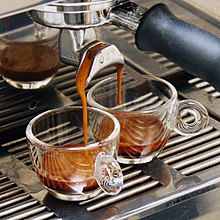Barista
This article includes a list of references, related reading, or external links, but its sources remain unclear because it lacks inline citations. (January 2010) |

A barista (buh-REE-stuh; from the Italian for "bartender") is a person, usually a coffee-house employee, who prepares and serves espresso-based coffee drinks.
Etymology and declension
The word barista is an Italian word, and in Italian, a barista is a male or female "bartender", who typically works behind a counter, serving both hot drinks (such as espresso), and cold alcoholic and non-alcoholic beverages, not a coffee-maker specifically.
The native plural in English is baristas, while in Italian the plural is baristi for masculine or mixed sex (baristi: "barmen", "bartenders") or bariste for feminine (bariste: "barmaids").
Application of the title

While the title is not regulated, most coffee shops use the title to describe the preparer of coffee and operator of an espresso machine.


Baristas generally operate a commercial espresso machine, and their role is preparing the shot and pulling the shot; the degree to which this is automated or done manually varies significantly, ranging from push-button operation to an involved manual process. Machines range from manual (lever), where the pressure is applied by hand, to semi-automatic, where the pressure is applied automatically but brew time is controlled by the barista, to automatic, where the brew time is also preset (but preparing the grinds is still manual), to super-automatic, where the barista need only load the beans and push a button, but is otherwise completely automated. Espresso is a notoriously finicky beverage, and thus good manual espresso making is considered a skilled task. Further, preparation of other beverages, particularly milk-based drinks such as cappuccinos and lattes, but also non-espresso coffee such as drip or press pot, requires additional work and skill for effective frothing, pouring and most often latte art.
Preparing the shot involves adjusting the grind of the beans, dosing (the amount of coffee used in the shot), tamping (pressing down the espresso in the basket), and often other preparation of the grounds (such as leveling, tapping, or stirring), with the goal of obtaining a desired extraction. Failures can range from slight errors (slight over or under extraction – too bitter or too weak; or uneven extraction – some parts over-extracted, some parts under-extracted) to significant errors (undrinkably harsh or watery) to complete failure (espresso does not brew successfully, water sprays everywhere, etc.), and thus good espresso-making is valued by connoisseurs. Correct procedure can vary with the beans (adjusting settings for new beans is called "dialing in") and over the course of the day (notably if humidity changes, particularly if not climate-controlled, such as outside), and there is thus often much tweaking of settings after initial setup in the morning.
The barista usually has been trained to operate the machine and to prepare the coffee based on the guidelines of the roaster or shop owner, while more experienced ones may have discretion to vary preparation or experiment, and a seasoned veteran will of course need little training beyond specifics of equipment and beans used and the shop's preferences. Beyond preparation, baristas may assist customers in selecting the beverage or beans, gauging or learning a customer's preferences.
Beyond the preparation of espresso (and other beverages) and general bartending skills (interaction with customers, handling and scheduling orders, etc.), skilled baristas acquire knowledge of the entire process of coffee to effectively prepare a desired cup of coffee, similar to how a sommelier is familiar with the entire process of wine making and consumption. This knowledge includes the correct operation, maintenance and programming of the machine, grinding and tamping methods, extraction times, water temperature and quality, micro milk frothing, free pouring, latte art, roasting, coffee plant cultivation, drying methods, correct storage, renewable methods of disposal, recycling of the coffee and packaging used. A barista can acquire these skills by attending barista training classes, but they are more commonly learned on the job.
Competition
Formal barista competitions originated in Norway,[1] and today the most prestigious is the World Barista Championships, held annually at varied international locations. Baristas worldwide compete, though they must first compete in a competition held in their own country to qualify to enter in the WBC.
See also
References
- ^ Wendelboe, Tim (May 1, 2005) The Future of the World Barista Championship. "CoffeeGeek.com" Retrieved on 2006-oct-25
